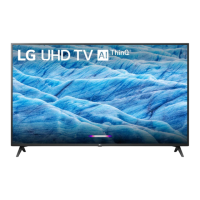
Do you have a question about the LG 50UM73 Series and is the answer not in the manual?
Essential safety warnings regarding fire, shock, and environmental conditions.
Guidelines for proper TV placement and airflow to prevent overheating and electrical hazards.
Instructions on electrical grounding, power cord handling, and battery safety.
Advice on safely moving the TV, preventing impacts, and proper cleaning methods.
Steps for initial TV setup, understanding OSD differences, and available menus.
Information on optional accessories and the basic functions of the Magic Remote.
Details on VESA standards, screws, and compatible wall mount brackets for different models.
Instructions for safely lifting, moving, and transporting the television.
Step-by-step guide for securely mounting the TV on a table and safety tips.
Procedures for securing the TV to a wall mount and information on necessary accessories.
Steps for attaching the optional wall mount bracket and important installation warnings.
Warnings about installation locations, oil exposure, and handling cable covers.
Connecting antennas, satellite dishes, and using CI modules for TV reception.
Guidance on connecting external devices via HDMI and USB ports for optimal quality.
Connecting various devices like Blu-ray players, gaming consoles, PCs, and using LAN.
Using the TV's physical button for basic functions and menu adjustments.
Instructions on battery replacement, pointing the remote, and button functions.
Operating the Magic Remote, battery replacement, and detailed button descriptions.
Addressing problems like remote control failure, no signal, or sudden power loss.
Information on accessing the embedded User Guide and general system information.
Explanations for pixel variations, brightness differences, and image sticking phenomena.
Information on normal operational sounds and precautions for cleaning the screen.
Technical details on digital and analogue TV broadcasting system and channel coverage.
Frequency ranges, output power, and specifications for Wireless LAN and Bluetooth modules.
Recommended operating and storage temperature and humidity ranges for the device.
Details on obtaining source code and license terms for open source software used.
Instructions for recording the TV's model and serial number for service purposes.
A table mapping remote control functions to their hexadecimal key codes for external control.
Connecting the TV using a USB to Serial converter for external device control.
Setting up the RS-232C connection using a DE9 cable for external control systems.
Connecting via phone jack or RS-232C, and understanding RS-232C configurations.
Procedures for accessing and setting the Set ID for controlling multiple TVs.
Baud rate, data length, parity, stop bit, and communication code for serial control.
A comprehensive list of commands and their corresponding hexadecimal data for TV control.
Format for transmitting commands and receiving acknowledgements or errors.
Understanding data formats, hexadecimal to decimal conversion, and ACK/NG responses.
Commands to turn the TV on/off and check its power status via serial interface.
Commands to adjust the TV's screen format and picture size.
Commands to mute the screen display or audio, and control volume levels.
Commands for adjusting TV tint, sharpness, and controlling OSD display visibility.
Commands for locking control panel, adjusting treble, bass, and balance.
Commands to adjust color temperature and control the ISM method for specific TV types.
Commands to adjust energy saving settings and initiate channel tuning.
Detailed commands for tuning analog and digital channels based on signal type and model.
Commands for tuning digital channels using physical, major, and minor number mapping.
Commands to skip channels, add/delete them, and send remote control key codes.
Commands to control the TV's backlight or panel light brightness.
Commands to select different input sources like DTV, AV, Component, and HDMI.
Commands to change 3D modes, picture correction, depth, and color settings.
Command to automatically adjust picture position and minimize image shaking in PC mode.
